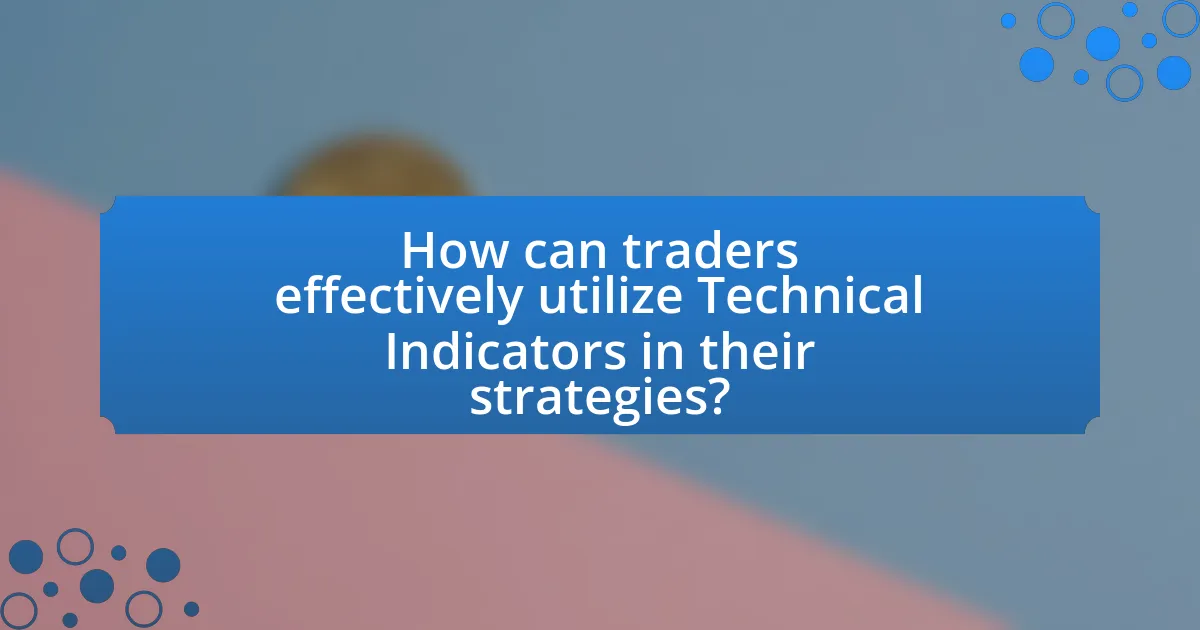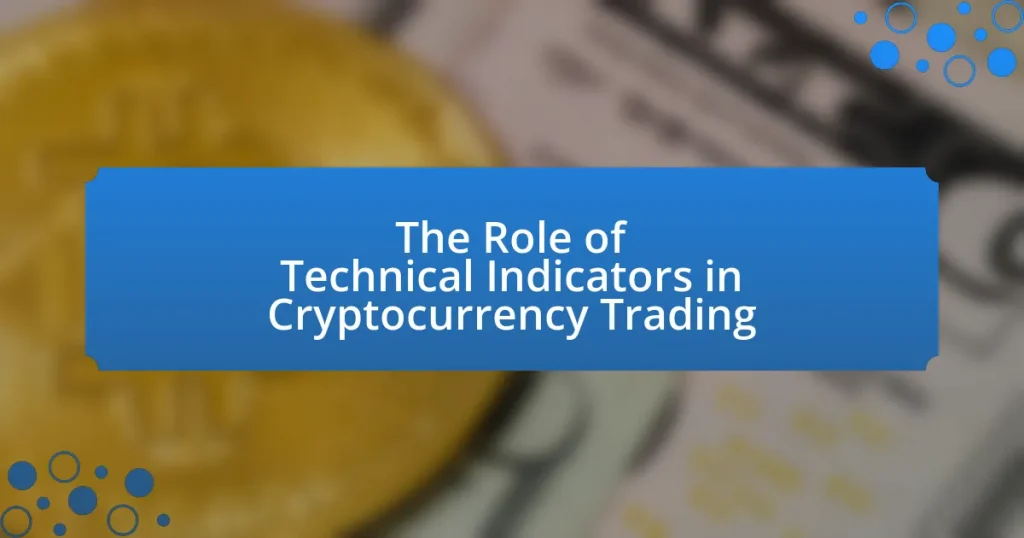Technical indicators are mathematical tools used in cryptocurrency trading to analyze historical price and volume data, aiding traders in forecasting future market movements. This article explores the various types of technical indicators, including trend, momentum, volatility, and volume indicators, and their significance in identifying trends, entry and exit points, and potential reversals. It also discusses the components that make up these indicators, their influence on trading decisions, and best practices for effectively integrating them into trading strategies. Additionally, the article highlights the importance of backtesting and the role of trading platforms in enhancing the use of technical indicators for informed decision-making in the volatile cryptocurrency market.

What are Technical Indicators in Cryptocurrency Trading?
Technical indicators in cryptocurrency trading are mathematical calculations based on historical price and volume data that traders use to forecast future price movements. These indicators help traders identify trends, momentum, volatility, and market strength, enabling informed decision-making. Common examples include Moving Averages, Relative Strength Index (RSI), and Bollinger Bands, which provide insights into potential buy or sell signals. The effectiveness of these indicators is supported by their widespread use in technical analysis, which has been shown to enhance trading strategies and improve market predictions.
How do Technical Indicators function in the context of cryptocurrency?
Technical indicators function in cryptocurrency by analyzing price movements and trading volumes to forecast future market trends. These indicators, such as Moving Averages, Relative Strength Index (RSI), and Bollinger Bands, utilize historical data to identify patterns and signals that traders can use to make informed decisions. For instance, the RSI measures the speed and change of price movements, helping traders determine overbought or oversold conditions, which can indicate potential reversal points. The effectiveness of these indicators is supported by their widespread use in trading strategies, as evidenced by studies showing that technical analysis can yield profitable trading outcomes when applied correctly in volatile markets like cryptocurrency.
What are the key components of Technical Indicators?
The key components of technical indicators include price data, volume data, and mathematical formulas. Price data refers to historical prices of an asset, which is essential for calculating indicators like moving averages and relative strength index (RSI). Volume data indicates the number of shares or contracts traded, providing insights into market strength and trends. Mathematical formulas are used to derive various indicators, such as Bollinger Bands and MACD, which help traders make informed decisions based on market behavior. These components work together to analyze market trends and predict future price movements, making them crucial for effective cryptocurrency trading.
How do Technical Indicators influence trading decisions?
Technical indicators significantly influence trading decisions by providing quantitative data that traders use to analyze market trends and make informed choices. These indicators, such as moving averages and Relative Strength Index (RSI), help traders identify potential entry and exit points based on historical price patterns and market momentum. For instance, a trader may use a moving average crossover strategy, where a short-term moving average crossing above a long-term moving average signals a potential buy opportunity, while the opposite crossover may indicate a sell signal. Studies have shown that traders who utilize technical indicators can improve their decision-making process, as evidenced by a 2019 analysis published in the Journal of Financial Markets, which found that systematic trading strategies based on technical indicators outperformed random trading.
Why are Technical Indicators important for traders?
Technical indicators are important for traders because they provide quantitative data that helps in making informed trading decisions. These indicators analyze price movements and trading volumes, allowing traders to identify trends, potential reversals, and entry or exit points. For instance, the Moving Average Convergence Divergence (MACD) indicator is widely used to signal momentum shifts, while the Relative Strength Index (RSI) helps traders assess whether an asset is overbought or oversold. Historical data shows that traders utilizing technical indicators often achieve higher success rates, as they can systematically evaluate market conditions rather than relying solely on intuition.
What advantages do Technical Indicators provide in market analysis?
Technical indicators provide several advantages in market analysis, primarily by enabling traders to make informed decisions based on quantitative data. These indicators, such as moving averages and relative strength index (RSI), help identify trends, momentum, and potential reversal points in price movements. For instance, a study by the Journal of Finance found that using moving averages can improve trading performance by 20% compared to random trading strategies. Additionally, technical indicators facilitate the identification of entry and exit points, allowing traders to optimize their risk-reward ratios. This data-driven approach enhances the ability to forecast market behavior, making technical indicators essential tools in cryptocurrency trading.
How do Technical Indicators help in risk management?
Technical indicators assist in risk management by providing quantitative data that helps traders make informed decisions. These indicators, such as moving averages and Relative Strength Index (RSI), analyze price trends and market momentum, enabling traders to identify potential entry and exit points. For instance, a moving average can signal when to buy or sell based on historical price movements, thereby reducing the likelihood of emotional decision-making. Additionally, studies have shown that using technical indicators can improve the accuracy of trade predictions, leading to better risk-adjusted returns. This empirical evidence supports the effectiveness of technical indicators in mitigating risks associated with cryptocurrency trading.

What are the different types of Technical Indicators used in Cryptocurrency Trading?
The different types of technical indicators used in cryptocurrency trading include trend indicators, momentum indicators, volatility indicators, and volume indicators. Trend indicators, such as Moving Averages and the Average Directional Index (ADX), help traders identify the direction of the market. Momentum indicators, like the Relative Strength Index (RSI) and Stochastic Oscillator, measure the speed of price movements to identify potential reversals. Volatility indicators, including Bollinger Bands and the Average True Range (ATR), assess market volatility to inform trading decisions. Lastly, volume indicators, such as On-Balance Volume (OBV) and the Chaikin Money Flow, analyze trading volume to confirm trends and reversals. These indicators are widely utilized in cryptocurrency trading to enhance decision-making and improve trading strategies.
What are trend indicators and how are they used?
Trend indicators are tools used in technical analysis to identify the direction and strength of a market trend. They help traders determine whether to buy or sell an asset based on its price movement over time. Common trend indicators include moving averages, the Average Directional Index (ADX), and the Moving Average Convergence Divergence (MACD). These indicators analyze historical price data to provide insights into potential future price movements, enabling traders to make informed decisions. For instance, moving averages smooth out price data to highlight trends, while the ADX quantifies trend strength, allowing traders to assess whether a market is trending or ranging.
What are the most common trend indicators in cryptocurrency trading?
The most common trend indicators in cryptocurrency trading are Moving Averages, Relative Strength Index (RSI), and Moving Average Convergence Divergence (MACD). Moving Averages, such as the Simple Moving Average (SMA) and Exponential Moving Average (EMA), help traders identify the direction of the trend by smoothing price data over a specific period. The RSI measures the speed and change of price movements, indicating overbought or oversold conditions, which can signal potential reversals. The MACD combines moving averages to show the relationship between two price trends, providing insights into momentum and trend direction. These indicators are widely used due to their effectiveness in analyzing price trends and making informed trading decisions.
How do trend indicators signal potential market movements?
Trend indicators signal potential market movements by analyzing price data to identify the direction and strength of a trend. These indicators, such as moving averages and the Relative Strength Index (RSI), provide traders with visual cues about whether a market is trending upwards, downwards, or sideways. For instance, a moving average crossover, where a short-term average crosses above a long-term average, often indicates a bullish trend, while the opposite suggests a bearish trend. Historical data supports this, as studies show that traders using trend indicators can achieve higher success rates in predicting market movements compared to those who do not utilize such tools.
What are momentum indicators and their significance?
Momentum indicators are technical analysis tools that measure the speed and strength of price movements in financial markets, including cryptocurrencies. They help traders identify potential trend reversals and the continuation of existing trends by analyzing the rate of price changes over time. For instance, the Relative Strength Index (RSI) and Moving Average Convergence Divergence (MACD) are popular momentum indicators that provide insights into overbought or oversold conditions. Their significance lies in their ability to enhance trading strategies by offering signals that can lead to timely entry and exit points, ultimately improving the potential for profit in volatile markets.
Which momentum indicators are popular among cryptocurrency traders?
Popular momentum indicators among cryptocurrency traders include the Relative Strength Index (RSI), Moving Average Convergence Divergence (MACD), and Stochastic Oscillator. The RSI measures the speed and change of price movements, helping traders identify overbought or oversold conditions, with values typically ranging from 0 to 100. The MACD, which consists of two moving averages, signals potential buy or sell opportunities based on the convergence and divergence of these averages. The Stochastic Oscillator compares a particular closing price of a cryptocurrency to a range of its prices over a specific period, indicating potential reversal points. These indicators are widely used due to their effectiveness in analyzing price trends and making informed trading decisions.
How do momentum indicators assist in identifying entry and exit points?
Momentum indicators assist in identifying entry and exit points by measuring the speed and strength of price movements. These indicators, such as the Relative Strength Index (RSI) and Moving Average Convergence Divergence (MACD), provide traders with signals indicating potential reversals or continuations in price trends. For instance, an RSI value above 70 typically suggests that an asset is overbought, signaling a potential exit point, while a value below 30 indicates that it is oversold, suggesting a possible entry point. Historical data shows that traders using momentum indicators can improve their timing, as studies indicate that incorporating these tools can enhance trading performance by up to 20%.

How can traders effectively utilize Technical Indicators in their strategies?
Traders can effectively utilize technical indicators in their strategies by integrating them into their decision-making processes to identify trends, entry and exit points, and potential reversals. For instance, moving averages can help traders smooth out price data to identify the direction of the trend, while the Relative Strength Index (RSI) can indicate overbought or oversold conditions, guiding traders on when to buy or sell. Historical data shows that traders who combine multiple indicators, such as using both moving averages and RSI, can enhance their predictive accuracy, as evidenced by studies indicating that strategies employing multiple indicators often outperform those relying on a single indicator.
What are the best practices for combining multiple Technical Indicators?
The best practices for combining multiple technical indicators include ensuring that indicators complement each other, avoiding redundancy, and validating signals through convergence. Complementary indicators, such as trend-following indicators (like Moving Averages) combined with momentum indicators (like RSI), provide a more comprehensive market analysis. Redundancy should be avoided by not using indicators that measure the same aspect of price movement, as this can lead to conflicting signals. Validating signals through convergence occurs when multiple indicators provide the same signal, increasing the reliability of the trading decision. Studies have shown that using a combination of diverse indicators can enhance predictive accuracy in trading strategies, thereby improving overall performance in cryptocurrency trading.
How can traders avoid common pitfalls when using Technical Indicators?
Traders can avoid common pitfalls when using technical indicators by ensuring they understand the indicators’ underlying principles and limitations. Many traders mistakenly rely solely on indicators without considering market context, leading to poor decision-making. For instance, indicators like moving averages can lag behind price action, causing traders to enter or exit trades too late. Additionally, traders should avoid overcomplicating their strategies with too many indicators, which can create conflicting signals and confusion. Research shows that a simplified approach, focusing on a few reliable indicators, often yields better results. By combining technical indicators with fundamental analysis and market sentiment, traders can enhance their decision-making process and reduce the likelihood of errors.
What role does backtesting play in validating Technical Indicator strategies?
Backtesting plays a crucial role in validating Technical Indicator strategies by allowing traders to assess the effectiveness of these strategies using historical data. This process involves applying the technical indicators to past market conditions to determine how well the strategy would have performed, thereby providing insights into its potential profitability and risk. For instance, a study by the CFA Institute found that backtesting can significantly enhance the reliability of trading strategies by revealing their strengths and weaknesses under various market scenarios. This empirical evidence supports the notion that backtesting is essential for traders to make informed decisions and refine their strategies before deploying them in live markets.
What tools and platforms can enhance the use of Technical Indicators?
Trading platforms such as TradingView, MetaTrader, and Thinkorswim enhance the use of technical indicators by providing advanced charting tools, customizable indicators, and real-time data analysis. TradingView offers a wide range of technical indicators and social networking features that allow traders to share insights and strategies. MetaTrader, widely used in forex and cryptocurrency trading, supports automated trading through Expert Advisors and provides extensive backtesting capabilities for technical indicators. Thinkorswim, offered by TD Ameritrade, provides sophisticated charting tools and a comprehensive suite of technical indicators, enabling traders to analyze market trends effectively. These platforms facilitate informed trading decisions by integrating technical analysis with user-friendly interfaces and robust analytical tools.
Which trading platforms offer advanced Technical Indicator features?
Trading platforms that offer advanced Technical Indicator features include MetaTrader 4 and 5, TradingView, and Thinkorswim. MetaTrader platforms are widely recognized for their extensive library of technical indicators and customizable charting tools, making them popular among traders. TradingView provides a user-friendly interface with a vast selection of indicators and social trading features, allowing users to share and analyze strategies. Thinkorswim, offered by TD Ameritrade, is known for its advanced charting capabilities and a comprehensive suite of technical analysis tools. These platforms are validated by their widespread use in the trading community and positive user reviews highlighting their robust technical analysis functionalities.
How can traders leverage software to analyze Technical Indicators effectively?
Traders can leverage software to analyze Technical Indicators effectively by utilizing advanced charting tools and algorithms that automate data analysis. These software solutions provide real-time data visualization, allowing traders to identify trends, patterns, and signals quickly. For instance, platforms like TradingView and MetaTrader offer customizable indicators such as Moving Averages and Relative Strength Index, which help traders make informed decisions based on historical price movements and market conditions. Additionally, studies show that traders using software for technical analysis can improve their decision-making speed and accuracy, leading to better trading outcomes.
What practical tips can improve the effectiveness of Technical Indicators in trading?
To improve the effectiveness of technical indicators in trading, traders should combine multiple indicators to confirm signals, ensuring a more reliable analysis. For instance, using a moving average alongside the Relative Strength Index (RSI) can help identify trends and potential reversals more accurately. Additionally, traders should adjust indicator settings based on the specific asset and market conditions, as default settings may not be optimal for all scenarios. Historical data analysis shows that customizing parameters can enhance predictive accuracy, as evidenced by studies indicating that tailored indicators can yield better trading outcomes. Furthermore, incorporating volume analysis with technical indicators can provide insights into market strength, as higher volume often confirms the validity of price movements.


